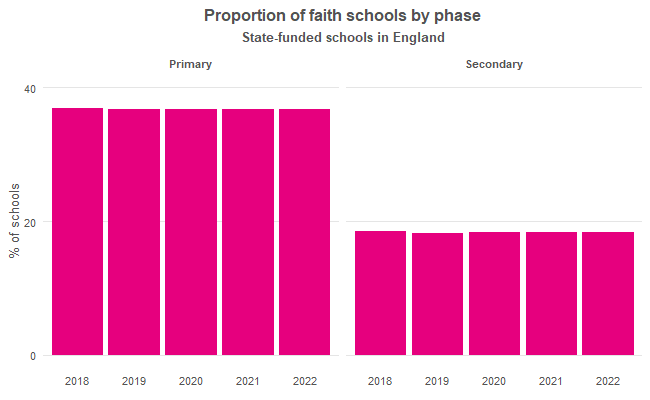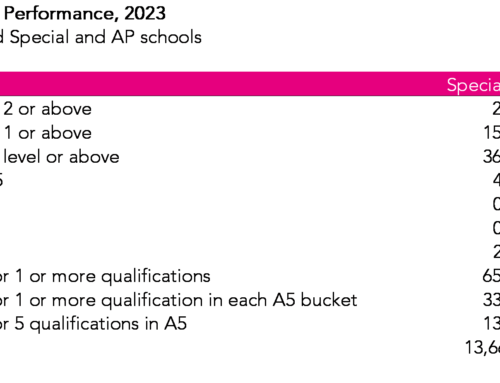*Updated on 4 November 2022. We have updated some charts and figures to correct errors in original calculations. This doesn’t affect any findings.*
In a previous post, we looked at the distribution of school types around the country, with an eye on how many could be urged to academise for the first time, or join larger trusts, under new government proposals.
As shown below, a substantial proportion of schools that have not yet academised are voluntary-aided or voluntary controlled schools, of which nearly all are faith schools.

The government has already put some effort into persuading these schools to join a trust, funding new faith school trusts around the country. And the draft of the new schools bill proposes new protections for academies’ religious character.
So what can we expect over the next few years?
Some background
Let’s start with a look at how many state-funded faith schools there actually are.
Faith schools make up a substantial minority of state-funded schools in England – nearly a third of schools (31%) identify as faith schools this year, and this proportion has remained consistent over the last five years.

There is some variation between regions. London currently has the lowest proportion of faith schools, at 25%, although the North East, East of England and Yorkshire are all similar at 26%. The South West and North West have the highest proportions at 36% and 42%.

A higher proportion of primary schools are faith schools than secondary schools. This year, 37% of primary schools are faith schools compared to 18% of secondary schools.
Which faith are faith schools?
The majority of faith schools – 68% in 2022 – are Church of England (CofE). Nearly a third (29%) are Catholic, 1% are other Christian faiths and 2% are non-Christian.

Things look a little different when we break schools down by phase. The majority of primary faith schools in 2022 (72%) are CofE, compared to just 34% of secondary faith schools.

The majority of secondary faith schools are Catholic (52%), compared to 26% of primary faith schools. They are also far more likely to be of another Christian faith (7% compared to 1% of primaries) or a non-Christian faith (6% compared to 1% of primaries) than primaries.
Faith schools and academies
Back to the government’s proposals. To work out how they might apply to faith schools, let’s first look at how many faith schools are already academies.

The proportion of faith schools that are academies has increased in recent years, up from 26% in 2018 to 38% in 2022. It is, however, still well below the proportion of non-faith schools, which currently stands at 48%.
The proposals also suggest that all trusts should work towards serving at least 7,500 pupils and / or including at least ten schools. So faith schools that are part of a small or single academy trust might also see some changes over the next few years if their trusts decide to expand or merge with others.

As shown above, faith academies are more likely to be part of larger academy trusts than other academies. This year, the majority of faith academies (58%) are part of a trust of ten or more schools, compared to 40% of other academies.
All in all, then, are the white paper’s proposals more or less likely to apply to faith schools than to other schools?
In fact, there’s not much in it. Based on 2022 data, 82% of faith schools and 83% of non-faith schools are not currently part of an academy trust with ten or more schools, either because they aren’t part of a trust at all or because they are in a small or single academy trust.
Faith academy trusts
When it comes to joining a trust, some faith schools might prefer to join a trust in which all the schools share the same faith.
Unfortunately, the published data doesn’t specify whether a trust is characterised as a faith trust or not, but we can get a good idea from looking at the faith of the schools within a trust.

Perhaps unsurprisingly, larger trusts are more likely than smaller trusts to have a mix of faith and non-faith schools. But they are also more likely to be ‘faith trusts’ – that is, trusts that only include schools from one faith.
This year, nearly a quarter (24%) of the largest trusts – those with twenty or more schools – are faith trusts.
But this still adds up to quite a small number of faith trusts, especially when you look at those for each individual faith.
There are currently just 27 Catholic trusts with ten or more schools, 16 CofE trusts, and none at all of any other faith.
Despite the relatively low number of faith trusts, the majority of those faith academies (52% in 2021) that are part of a multi-academy trust are in a faith trust. So we might expect to see an increase in demand for faith trusts as more faith schools academise.
In conclusion
As things stand, faith schools are less slightly likely than non-faith schools to be part of an academy trust, although those that are already in a trust are likely to be part of a larger trust of ten or more schools.
Over the next few years, we may see more faith trusts forming, or considerable expansion of those that already exist. At the same time, we may see more faith schools joining trusts that include non-faith schools, or schools of other faiths.
Thanks to Steve Rollett for comments on a draft of this article.
Want to stay up-to-date with the latest research from FFT Education Datalab? Sign up to Datalab’s mailing list to get notifications about new blogposts, or to receive the team’s half-termly newsletter.






Following the memorandum of understanding between the Church of England and the DfE, it is now the case that all CE schools – if joining a MAT – have to join a majority church-led MAT. This limits the options for being in a trust with other local. community schools and has a significant bearing on decision-making for governing bodies.